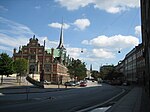Danish National Archives

The Danish National Archives (Danish: Rigsarkivet) is the national archive system of Denmark. Its primary purpose is to collect, preserve and archive historically valuable records from central authorities, such as ministries, agencies and national organisations and make them available to the public. The archive is part of the Ministry of Culture. Previously the term Danish State Archives (Danish: Statens Arkiver) was used as the collective name for the archive system. In 2014 the archives were reorganised, and the name Rigsarkivet (which had previously only applied to the Danish National Archives in Copenhagen) became the new collective name for the entire archive system.
Excerpt from the Wikipedia article Danish National Archives (License: CC BY-SA 3.0, Authors, Images).Danish National Archives
Proviantpassagen, Copenhagen Christianshavn
Geographical coordinates (GPS) Address Nearby Places Show on map
Geographical coordinates (GPS)
| Latitude | Longitude |
|---|---|
| N 55.675555555556 ° | E 12.581111111111 ° |
Address
Proviantpassagen
Proviantpassagen
1218 Copenhagen, Christianshavn
Capital Region of Denmark, Denmark
Open on Google Maps








